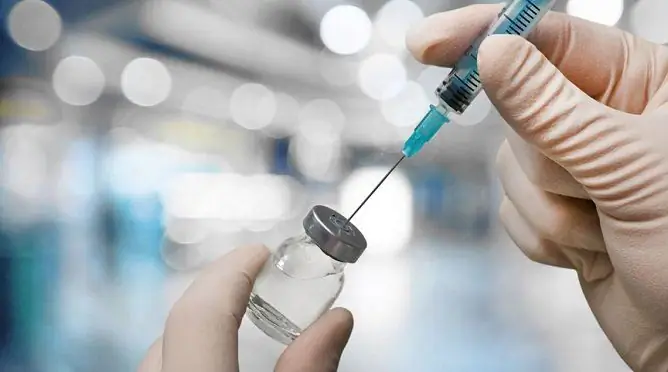- Author Rachel Wainwright [email protected].
- Public 2023-12-15 07:39.
- Last modified 2025-11-02 20:14.
Polyorix
Polyorix: instructions for use and reviews
- 1. Release form and composition
- 2. Pharmacological properties
- 3. Indications for use
- 4. Contraindications
- 5. Instructions for use a: scab and dosage
- 6. Side effects
- 7. Overdose
- 8. Special instructions
- 9. Application during pregnancy and lactation
- 10. Use in childhood
- 11. Drug interactions
- 12. Analogs
- 13. Terms and conditions of storage
- 14. Terms of dispensing from pharmacies
- 15. Reviews
- 16. Price in pharmacies
Latin name: Poliorix
ATX code: J07BF03
Active ingredient: inactivated poliovirus types 1, 2 and 3 (poliovirus)
Manufacturer: GlaxoSmithKline Biologicals S. A. (Belgium)
Description and photo update: 2018-26-10

Poliorix - vaccine for the prevention of poliomyelitis; inactivated trivalent poliomyelitis virus.
Release form and composition
Poliorix is produced in the form of a solution for intramuscular (i / m) administration: a colorless transparent liquid without visible foreign inclusions (1 dose / 0.5 ml in a glass bottle, in a cardboard box 1, 10 or 100 bottles; 2 doses / 1 ml or 10 doses / 5 ml in a glass bottle, in a cardboard box 1, 10, 50 or 100 bottles).
Composition of 1 dose / 0.5 ml solution:
- active substances: inactivated poliovirus type 1 (D-antigen) in units of enzyme-linked immunosorbent assay (ELISA) - 40 units, inactivated poliovirus type 2 (D-antigen) - 8 units, inactivated poliovirus type 3 (D-antigen c) - 32 units;
- additional components: formaldehyde, 2-phenoxyethanol, polysorbate 80, medium 199 (M199) *, water for injection.
* The composition of medium 199 (M199) includes: sodium chloride, potassium dihydrogen phosphate, sodium hydrogen phosphate, iron nitrate nonahydrate, magnesium sulfate heptahydrate, potassium chloride, calcium chloride dihydrate, sodium bicarbonate, L-aspartic acid, L-alanine, L-cysteine hydrochloride, L-arginine hydrochloride, L-glutamic acid, L-histidine hydrochloride monohydrate, glycine, L-cystine, L-glutamine, L-hydroxyproline, L-lysine hydrochloride, L-isoleucine, L-methionine, L-leucine, L- phenylalanine, L-threonine, L-tyrosine, L-proline, L-tryptophan, L-serine, L-valine, alpha-tocopherol, calcium pantothenate, ascorbic acid, biotin, calciferol, menadione, choline chloride, nicotinic acid, inositol, nicotinamide, folic acid, para-aminobenzoic acid, pyridoxine hydrochloride, thiamine hydrochloride, pyridoxal hydrochloride, riboflavin, adenosine phosphate, retinol acetate,adenosine sodium triphosphate, deoxyribose, adenine, cholesterol, hypoxanthine, glucose, ribose, glutathione, sodium acetate, guanine hydrochloride, uracil, thymine, xanthine, polysorbate 80.
Pharmacological properties
Pharmacodynamics
The Poliorix vaccine contains inactivated purified polio viruses types 1, 2 and 3, cultured on Vero cells and inactivated with formaldehyde. The vaccine meets all the requirements of the World Health Organization for the production of medical immunobiological preparations.
Neutralizing antibodies to all three serotypes of poliovirus after the second dose of the vaccine as part of the primary course of vaccination were detected in 97-100% of the vaccinated, and after the third dose - in all vaccinated patients.
Indications for use
According to the instructions, Poliorix is recommended for immunization in order to prevent poliomyelitis.
Contraindications
- hypersensitivity reactions to previous administration of inactivated poliomyelitis vaccines;
- hypersensitivity to any of the components of Polyorix.
The introduction of the drug should be postponed in the presence of a febrile condition, including due to an exacerbation of chronic diseases.
Instructions for use of Poliorix: method and dosage
The Poliorix vaccine is injected deeply into the / m, for children under 1 year of age - in the upper outer surface of the middle part of the thigh, for older children - in the deltoid muscle.
It is allowed to use only preparations visually corresponding to the above description. Solutions that are cloudy, colored and / or contain visible inclusions must be disposed of.
When using the drug from a multi-dose vial, each dose should be taken with a sterile syringe with a sterile needle, which then needs to be injected with the vaccine. It is forbidden to keep the needle in the bottle cap to take subsequent doses of the solution.
The vaccine contained in an opened multi-dose vial can be used throughout the day if the antiseptic rules (above) are followed and stored under appropriate conditions (2-8 ° C). Opened vaccine vials must be destroyed at the end of the working day in accordance with the established rules.
Polyorix is administered in a single dose of 0.5 ml. For the prevention of poliomyelitis, the following vaccination course is recommended, approved by the National Calendar of Preventive Vaccinations of the Russian Federation: 3-4.5-6 months.
The first and second vaccinations are carried out with an inactivated vaccine, the third vaccination, as well as revaccination at 18, 20 months and at 14 years old - with a live vaccine for the prevention of poliomyelitis. Live polio vaccine is administered in accordance with the instructions for its use.
The third vaccination (at the age of 6 months) and further revaccinations for children with HIV infection, born to mothers with HIV infection or in children's homes, require an inactivated vaccine to prevent poliomyelitis.
Side effects
Due to the simultaneous administration of Poliorix with other vaccines, it is not possible to determine the exact causal relationship between the occurrence of adverse events and the use of the vaccine.
During clinical trials, 1105 children received 2323 doses of the drug. Most of the identified side effects of the drug were short-term and mild.
According to data from clinical studies, the following disorders were noted:
- metabolism and nutrition: very often - loss of appetite;
- gastrointestinal tract: often - vomiting, diarrhea;
- nervous system: very often - irritability, drowsiness, pathological crying, anxiety;
- local and general reactions: very often - fever, at the injection site - swelling, soreness and redness.
During post-registration observation from the immune system, allergic reactions were noted, including anaphylactoid and anaphylactic.
Overdose
Overdose cases have not been reported.
special instructions
During the use of Polyorix, like other injectable vaccines, it is necessary to provide the possibility of providing medical care in the event of an anaphylactic reaction, as well as monitoring the patient for 20 minutes after the administration of the drug.
After, and sometimes even before vaccination, there may be a psychological reaction to the injection in the form of fainting or severe weakness. Before the introduction of Polyorix, you should make sure that the patient will not be injured in case of fainting.
Before the appointment of the vaccine, the doctor should conduct an examination and study the history of the child, paying particular attention to previous vaccinations and the associated development of adverse reactions.
In the presence of lesions, infectious and non-infectious in an acute form, as well as exacerbations of chronic diseases, routine vaccination is recommended 2-4 weeks after recovery or during convalescence / remission.
In the case of mild forms of acute respiratory viral infections, acute intestinal diseases, and other minor manifestations of disease, vaccinations are prescribed immediately after the temperature has returned to normal.
In patients with immune disorders caused by the course of immunosuppressive therapy, HIV infection or a genetic defect, with the introduction of Polyorix, a reduced immune response is possible.
Polyorix can contain trace amounts of polymyxin and neomycin used during production and then almost completely removed. As a result, if there is a history of hypersensitivity to these antibacterial agents, the drug must be used with caution.
The vaccine should also be administered with caution in patients with blood clotting disorders or thrombocytopenia, since the intramuscular injection of the solution can provoke bleeding in them.
When carrying out a course of primary vaccination in premature infants (gestation less than 28 weeks), especially in children with respiratory distress syndrome, within 48-72 hours after drug administration, it is necessary to take into account the potential risk of apnea and monitor respiratory function. In such cases, it is advisable to vaccinate in a hospital setting.
Premature infants should be vaccinated when stabilization is achieved, subject to adequate weight gain.
Under no circumstances should Polyorix be administered intravenously.
Application during pregnancy and lactation
There is no adequate data on the effect of Polyorix during pregnancy and lactation on the mother and fetus / child.
Pediatric use
The drug is used to prevent poliomyelitis in children aged 3 months.
Drug interactions
Polyorix can be used in combination with other vaccines (except for the anti-tuberculosis vaccines BCG and BCG-M), used within the framework of the National Calendar of Preventive Vaccinations of the Russian Federation, provided that they are injected with different syringes in different parts of the body.
Analogs
Analogs of Poliorix are: Imovax Polio, Oral poliomyelitis vaccine 1, 2 and 3 types; BiVak polio, POLIMILEKS.
Terms and conditions of storage
Store out of the reach of children at 2-8 ° C, without freezing.
The shelf life is 3 years.
Terms of dispensing from pharmacies
Dispensed by prescription.
Reviews about Poliorix
Reviews about Poliorix are varied. According to many parents, the introduction of an inactivated vaccine is safer than the use of a live one, since it excludes the development of vaccine-associated poliomyelitis. In many cases, the drug is well tolerated without adverse reactions.
Sometimes it is indicated that anxiety, irritability, or a slight fever occur for several days after vaccination. There are also such reviews about Poliorix, in which the appearance after its introduction (especially after the second and third vaccinations) of pain and swelling at the injection site, a pronounced manifestation of rash, diarrhea, and high temperature, which can last 3-5 days, is noted. In some cases, the development of individual side effects is observed only on the eighth day after vaccination.
Almost all parents recommend giving the child antihistamines for three days before and after the administration of the drug.
Price for Poliorix in pharmacies
The reliable price for Poliorix is unknown, since the drug is currently not available for sale.

Maria Kulkes Medical journalist About the author
Education: First Moscow State Medical University named after I. M. Sechenov, specialty "General Medicine".
Information about the drug is generalized, provided for informational purposes only and does not replace the official instructions. Self-medication is hazardous to health!






